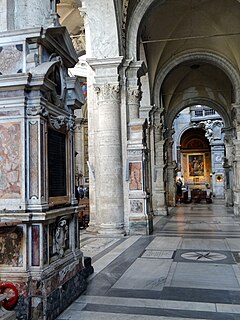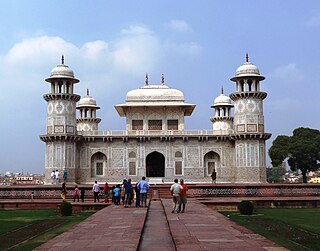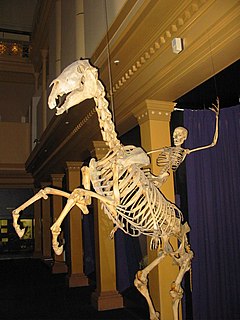
Arnolfo di Cambio was an Italian architect and sculptor.

Andrea dal Monte Sansovino or Andrea Contucci del Monte San Savino was an Italian sculptor active during the High Renaissance. His pupils include Jacopo Sansovino.

An effigy is a representation of a specific person in the form of sculpture or some other three-dimensional medium. The use of the term is normally restricted to certain contexts in a somewhat arbitrary way: recumbent effigies on tombs are so called, but standing statues of individuals, or busts, are usually not. Likenesses of religious figures in sculpture are not normally called effigies. Effigies are common elements of funerary art, especially as a recumbent effigy in stone or metal placed on a tomb, or a less permanent "funeral effigy", placed on the coffin in a grand funeral, wearing real clothing.

A monumental brass is a type of engraved sepulchral memorial which in the 13th century began to partially take the place of three-dimensional monuments and effigies carved in stone or wood. Made of hard latten or sheet brass, let into the pavement, and thus forming no obstruction in the space required for the services of the church, they speedily came into general use, and continued to be a favourite style of sepulchral memorial for three centuries.

A church monument is an architectural or sculptural memorial to a deceased person or persons, located within a Christian church. It can take various forms ranging from a simple commemorative plaque or mural tablet affixed to a wall, to a large and elaborate structure, on the ground or as a mural monument, which may include an effigy of the deceased person and other figures of familial, heraldic or symbolic nature. It is usually placed immediately above or close to the actual burial vault or grave, although very occasionally the tomb is constructed within it. Sometimes the monument is a cenotaph, commemorating a person buried at another location.

Andrea di Cristoforo Bregno (1418–1506) was an Italian sculptor and architect of the Early Renaissance who worked in Rome from the 1460s and died just as the High Renaissance was getting under way.

The Tomb of Antipope John XXIII is the marble-and-bronze tomb monument of Antipope John XXIII, created by Donatello and Michelozzo for the Florence Baptistry adjacent to the Duomo. It was commissioned by the executors of Cossa's will after his death on December 22, 1419 and completed during the 1420s, establishing it as one of the early landmarks of Renaissance Florence. According to Ferdinand Gregorovius, the tomb is "at once the sepulchre of the Great Schism in the church and the last papal tomb which is outside Rome itself".

Juste or Giusti is the name conventionally applied to a family of Italian sculptors.

The Royal Monastery of Brou is a religious complex located at Bourg-en-Bresse in the Ain département, central France. Made out of monastic buildings in addition to a church, they were built at the beginning of the 16th century by Margaret of Austria, daughter of the Holy Roman Emperor Maximilian I and Governor of the Habsburg Netherlands. The complex was designed as a dynastic burial place in the tradition of the Burgundian Champmol and Cîteaux Abbey, and the French Saint-Denis. The church is known as the Église Saint-Nicolas-de-Tolentin de Brou in French.

The Della Rovere or Saint Jerome Chapel, otherwise the Chapel of the Nativity is the first side chapel in the south aisle of the Basilica of Santa Maria del Popolo in Rome. It was dedicated to the Virgin and Saint Jerome and decorated with the paintings of Pinturicchio and his pupils. It is one of the best preserved monuments of quattrocento art in Rome.

The Costa or St Catherine Chapel is located in the south aisle of the Basilica of Santa Maria del Popolo in Rome. This is the fourth side chapel from the counterfaçade and was dedicated to St Catherine of Alexandria. The lunettes were painted by the helpers of Pinturicchio and the marble altar-piece is attributed to Gian Cristoforo Romano.

The Montemirabile or Saint John the Baptist Chapel, otherwise the Baptistery is the first side chapel in the left aisle in the Basilica of Santa Maria del Popolo.

Monuments in the Basilica of Santa Maria del Popolo are tombs and funerary monuments ranging from the 15th to the 19th centuries. Since its rebuilding in the 1470s by Pope Sixtus IV the Basilica of Santa Maria del Popolo was one of the favourite burial places for members of the papal aristocracy, clergy and literati. Foreign artists were also buried in the church due to its location near their favourite quarter in Rione Campo Marzio. The high number of tombs and monuments makes the basilica a whole museum of sculpture as Jacob Burckhardt phrased it in his famous guide of Italian art in 1855. Besides the tombs in the side chapels and the choir there are many other funeral monuments in the aisles and the transept.

Conrad Meit or Conrat Meit was a German-born Late Gothic and Renaissance sculptor, who spent most of his career in the Low Countries.

A ledger stone or ledgerstone is an inscribed stone slab usually laid into the floor of a church to commemorate or mark the place of the burial of an important deceased person. The term "ledger stone" derives from the German word legen, meaning to lie. Ledger stones may also be found as slabs forming the tops of tomb chest monuments.

The monumental brass of John Rudying is a brass of 1481 to Archdeacon John Rudying in the Church of St Andrew in Biggleswade in Bedfordshire noted for the surviving Figure of Death. The monument was rediscovered under the chancel floor in 1955 during restoration and has been described as "very remarkable" by English Heritage.

The Tomb of Louis XII and Anne of Brittany is a large and complex silver-gilt and marble sculptured funerary monument. Its design and build are usually attributed to the Juste brothers although the work of several other hands can be distinguished. Design for and installed at the Saint-Denis Basilica, France, it was commissioned in 1515 in memory of Louis XII and his queen Anne of Brittany, probably by Louis' successor Francis I, and after years of design and intensive building was unveiled in 1531.




































